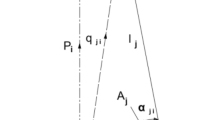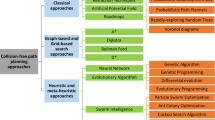Abstract
With its flexibility of a collaboration robot and demands for maintaining virtual model’s fidelity in cyber-physical system of robotic manufacturing, frequent calibration is required. This paper proposes a cost-effective calibration method of a collaborative robot using a single wire encoder. First, DH (Denavit-Hartenberg) convention-based kinematics of the robot are analyzed. Then, a mathematical relation between distance errors between robot’s end effector and wire encoder and the kinematic parameters are presented. In the experiment, turning-in-place-based measurement methodology is applied. Also, in order to reduce error caused by wire bending at the point where a wire is hooked in previous studies, a rotatable wire hanger which has 2-DoF (Degree of Freedom) rotary joint is fabricated and applied. Next, identifiable parameters are analyzed through SVD (Singular value decomposition), then 21 parameters are calculated via Levenberg–Marquardt algorithm. The estimated parameters were validated by comparing fidelity of the calibrated and nominal model against actual physical system measured by a robot arm type measurement device. As a result, feasibility of the proposed method was checked by confirming 64.3% better fidelity of the calibrated model using the proposed method. Furthermore, the performance of the method also shows better results than camera-based robot’s internal calibration function provided by manufacturer.










Similar content being viewed by others
References
Son, J., Kang, H., & Kang, S. H. (2023). A review on robust control of robot manipulators for future manufacturing. International Journal of Precision Engineering and Manufacturing, 24(6), 1083–1102. https://doi.org/10.1007/s12541-023-00812-9
Park, J., An, B., Kwon, O., Yi, H., & Kim, C. (2022). User intention based intuitive mobile platform control: Application to a patient transfer robot. International Journal of Precision Engineering and Manufacturing, 23(6), 653–666. https://doi.org/10.1007/s12541-022-00656-9
Stepanova, K., Rozlivek, J., Puciow, F., Krsek, P., Pajdla, T., & Hoffmann, M. (2022). Automatic self-contained calibration of an industrial dual-arm robot with cameras using self-contact, planar constraints, and self-observation. Robotics and Computer-Integrated Manufacturing, 73, 102250. https://doi.org/10.1016/j.rcim.2021.102250
Stepanova, K., Pajdla, T., & Hoffmann, M. (2019). Robot self-calibration using multiple kinematic chains—A simulation study on the iCub humanoid robot. IEEE Robotics and Automation Letters, 4(2), 1900–1907. https://doi.org/10.1109/LRA.2019.2898320
Malik, A. A., Masood, T., & Bilberg, A. (2020). Virtual reality in manufacturing: Immersive and collaborative artificial-reality in design of human-robot workspace. International Journal of Computer Integrated Manufacturing, 33(1), 22–37. https://doi.org/10.1080/0951192X.2019.1690685
Yun, H., & Jun, M. B. G. (2022). Immersive and interactive cyber-physical system (I2CPS) and virtual reality interface for human involved robotic manufacturing. Journal of Manufacturing Systems, 62, 234–248. https://doi.org/10.1016/j.jmsy.2021.11.018
Kim, W. S. (1996). Virtual reality calibration and preview/predictive displays for telerobotics. Presence: Teleoperators and Virtual Environments, 5(2), 173–190. https://doi.org/10.1162/pres.1996.5.2.173
Wang, Q., Cheng, Y., Jiao, W., Johnson, M. T., & Zhang, Y. (2019). Virtual reality human-robot collaborative welding: A case study of weaving gas tungsten arc welding. Journal of Manufacturing Processes, 48, 210–217. https://doi.org/10.1016/j.jmapro.2019.10.016
Xiao, P., Ju, H., Li, Q., Meng, J., & Chen, F. (2020). A new fixed axis-invariant based calibration approach to improve absolute positioning accuracy of manipulators. IEEE Access, 8, 134224–134232. https://doi.org/10.1109/ACCESS.2020.3011328
Chen, T., Lin, J., Wu, D., & Wu, H. (2021). Research of calibration method for industrial robot based on error model of position. Applied Sciences, 11(3), 1287. https://doi.org/10.3390/app11031287
Jiang, Y., Yu, L., Jia, H., Zhao, H., & Xia, H. (2020). Absolute positioning accuracy improvement in an industrial robot. Sensors, 20(16), 4354. https://doi.org/10.3390/s20164354
Nubiola, A., & Bonev, I. A. (2014). Absolute robot calibration with a single telescoping ballbar. Precision Engineering, 38(3), 472–480. https://doi.org/10.1016/j.precisioneng.2014.01.001
Yang, P., Guo, Z., & Kong, Y. (2020). Plane kinematic calibration method for industrial robot based on dynamic measurement of double ball bar. Precision Engineering, 62, 265–272. https://doi.org/10.1016/j.precisioneng.2019.12.010
Zhuang, H., & Roth, Z. S. (2020). Camera-Aided Robot Calibration. CRC Press. https://doi.org/10.1201/9781315138725
Meng, Y., & Zhuang, H. (2007). Autonomous robot calibration using vision technology. Robotics and Computer-Integrated Manufacturing, 23(4), 436–446. https://doi.org/10.1016/j.rcim.2006.05.002
Švaco, M., Šekoranja, B., Šuligoj, F., & Jerbić, B. (2014). Calibration of an industrial robot using a stereo vision system. Procedia Engineering, 69, 459–463. https://doi.org/10.1016/j.proeng.2014.03.012
Wang, R., Wu, A., Chen, X., & Wang, J. (2020). A point and distance constraint based 6R robot calibration method through machine vision. Robotics and Computer-Integrated Manufacturing, 65, 101959. https://doi.org/10.1016/j.rcim.2020.101959
Nadeau, N. A., Bonev, I. A., & Joubair, A. (2019). Impedance control self-calibration of a collaborative robot using kinematic coupling. Robotics, 8(2), 33. https://doi.org/10.3390/robotics8020033
Gaudreault, M., Joubair, A., & Bonev, I. (2018). Self-calibration of an industrial robot using a novel affordable 3D measuring device. Sensors, 18(10), 3380. https://doi.org/10.3390/s18103380
Icli, C., Stepanenko, O., & Bonev, I. (2020). New method and portable measurement device for the calibration of industrial robots. Sensors, 20(20), 5919. https://doi.org/10.3390/s20205919
Bennett, D. J., & Hollerbach, J. M. (1991). Autonomous calibration of single-loop closed kinematic chains formed by manipulators with passive endpoint constraints. IEEE transactions on Robotics and Automation, 7(5), 597–606.
Thomas, F., Ottaviano, E., Ros, L., & Ceccarelli, M. (2005). Performance analysis of a 3–2–1 pose estimation device. IEEE Transactions on Robotics, 21(3), 288–297. https://doi.org/10.1109/TRO.2004.840894
Legnani, G., & Tiboni, M. (2014). Optimal design and application of a low-cost wire-sensor system for the kinematic calibration of industrial manipulators. Mechanism and Machine Theory, 73, 25–48. https://doi.org/10.1016/j.mechmachtheory.2013.09.005
Driels, M. R., & Swayze, W. E. (1994). Automated partial pose measurement system for manipulator calibration experiments. IEEE Transactions on Robotics and Automation, 10(4), 430–440. https://doi.org/10.1109/70.313094
Jeong, J. W., Kim, S. H., Kwak, Y. K., & Smith, C. C. (1998). Development of a parallel wire mechanism for measuring position and orientation of a robot end-effector. Mechatronics, 8(8), 845–861. https://doi.org/10.1016/S0957-4158(98)00034-8
Hayati, S., & Mirmirani, M. (1985). Improving the absolute positioning accuracy of robot manipulators. Journal of Robotic Systems, 2(4), 397–413. https://doi.org/10.1002/rob.4620020406
Acknowledgements
The authors acknowledge the support by Wabash Heartland Innovation Network (WHIN) and Indiana Manufacturing Competitiveness Center (IN-MAC), and Institute of Information & communications Technology Planning & Evaluation (IITP) grant funded by the Korea government (MSIT), No. 2021-0-01577, AI-based robot monitoring & operation for surface finishing.
Author information
Authors and Affiliations
Corresponding authors
Additional information
Publisher's Note
Springer Nature remains neutral with regard to jurisdictional claims in published maps and institutional affiliations.
Rights and permissions
Springer Nature or its licensor (e.g. a society or other partner) holds exclusive rights to this article under a publishing agreement with the author(s) or other rightsholder(s); author self-archiving of the accepted manuscript version of this article is solely governed by the terms of such publishing agreement and applicable law.
About this article
Cite this article
Jeon, H., Jun, M.B.G., Yang, SH. et al. Cost-Effective Calibration of Collaborative Robot Arm with Single Wire Encoder. Int. J. Precis. Eng. Manuf. 24, 1615–1623 (2023). https://doi.org/10.1007/s12541-023-00886-5
Received:
Revised:
Accepted:
Published:
Issue Date:
DOI: https://doi.org/10.1007/s12541-023-00886-5




